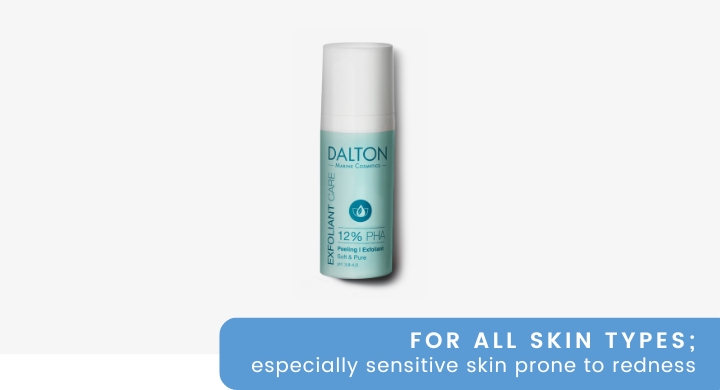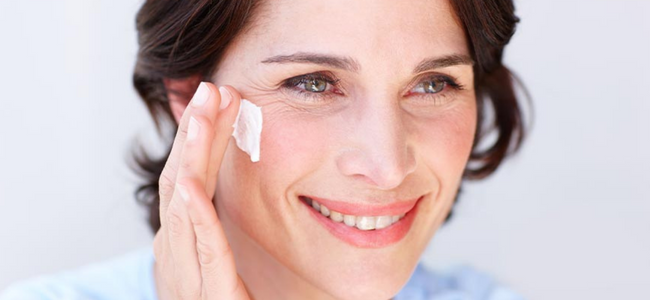

DALTON Chemical Peels - Professional At-Home Treatment
Straightforward and easy to use, yet sophisticated in their capabilities. These chemical peels show significantly better results than can be expected from a regular acid peel.
There is no mystery behind the unique workings of our three chemical peels, but over 45 years of experience in the field of marine cosmetics. Highly concentrated acids are combined with marine ingredients for incomparable results: Effective solutions for various skin types and needs.
How do chemical peels work?
Chemical peels are very powerful and help your skin treat a variety of problems. They exfoliate dead skin cells, visibly refine the skin's texture, reduce uneven skin tone and promote skin renewal.
It all comes down to the right mix
There are three different types of acids, which produce different effects on the skin -AHAs, BHAs and PHAs.


AHA (Alpha hydroxy acid)
This water-soluble group of acids includes glycolic, lactic, mandelic and tartaric acid as well as fruit acids from apples or lemons. AHAs exfoliate dead skin cells from the surface of the skin, promoting a smooth and even complexion. Pimple marks and hyperpigmentation (dark spots) can also be reduced with the help of AHAs. Plus, they help to keep the skin hydrated and have great anti-aging properties, as they stimulate collagen and hyaluronic acid production in the skin.
BHA (Beta hydroxy acid)
BHA, also known as salicylic acid, is oil-soluble. It unclogs pores, regulates sebum production and reduces inflammation and hyperkeratosis. Perfect for oily skin that is prone to blemishes and acne, and also for combination skin. Compared to the high concentrations of other chemical peels, the concentration of BHA in cosmetic peels must not exceed 2% Even this 2% is highly effective and the skin is visibly improved.
PHA (Poly hydroxy acid)
This group of acids includes gluconolactone and lactobionic acid. These acids are very mild and gentle, yet no less effective. Therefore, they are perfect for sensitive skin types or as a beginner-level chemical peel treatment. They strengthen the skin barrier and provide deep hydration.
AHA (Alpha hydroxy acid)
This water-soluble group of acids includes glycolic, lactic, mandelic and tartaric acid as well as fruit acids from apples or lemons. AHAs exfoliate dead skin cells from the surface of the skin, promoting a smooth and even complexion. Pimple marks and hyperpigmentation (dark spots) can also be reduced with the help of AHAs. Plus, they help to keep the skin hydrated and have great anti-aging properties, as they stimulate collagen and hyaluronic acid production in the skin.
BHA (Beta hydroxy acid)
BHA, also known as salicylic acid, is oil-soluble. It unclogs pores, regulates sebum production and reduces inflammation and hyperkeratosis. Perfect for oily skin that is prone to blemishes and acne, and also for combination skin. Compared to the high concentrations of other chemical peels, the concentration of BHA in cosmetic peels must not exceed 2% Even this 2% is highly effective and the skin is visibly improved.
PHA (Poly hydroxy acid)
This group of acids includes gluconolactone and lactobionic acid. These acids are very mild and gentle, yet no less effective. Therefore, they are perfect for sensitive skin types or as a beginner-level chemical peel treatment. They strengthen the skin barrier and provide deep hydration.
Physical exfoliants and enzyme peels: How are they different from chemical peels?
Not all peels are created equal. Each type of exfoliant brings different benefits, depending on what your skin needs. What they do have in common, however: They refine the skin's texture, even out skin tone, remove dead skin cells and they should definitely be a regular part of your skincare routine.


1. Physical exfoliants contain small abrasives (like sugar grains, silica beads or fruit pits) to remove dead skin cells from the top layer of skin. Applying the scrub also creates a gentle massage, which stimulates blood flow and gives the skin a fresh complexion immediately.


2. Enzyme peels do not contain any abrasive granules at all. They rely on enzymes to break down the proteins and lipids attached to dead skin, so it can be removed easily. This kind of gentle exfoliation is great for sensitive skin.


3. Chemical peels visibly refine the top layer of the skin and they have a much deeper effect than other kinds of peels. They smooth fine lines and wrinkles, balance the skin's moisture levels, reduce the look of dark spots and clear clogged pores.


1. Physical exfoliants contain small abrasives (like sugar grains, silica beads or fruit pits) to remove dead skin cells from the top layer of skin. Applying the scrub also creates a gentle massage, which stimulates blood flow and gives the skin a fresh complexion immediately.


2. Enzyme peels do not contain any abrasive granules at all. They rely on enzymes to break down the proteins and lipids attached to dead skin, so it can be removed easily. This kind of gentle exfoliation is great for sensitive skin.


3. Chemical peels visibly refine the top layer of the skin and they have a much deeper effect than other kinds of peels. They smooth fine lines and wrinkles, balance the skin's moisture levels, reduce the look of dark spots and clear clogged pores.
Chemical Peels by DALTON
Our DALTON exfoliants are characterized by a very special combination of ingredients.
High concentrations meet an effective mix of carefully selected acids, deep-acting marine minerals and other powerful ingredients from the sea, such as green algae, spirulina and brown algae.
That is all it takes to get the most out of your skin, which is also why the products do not contain any fragrances, dyes, microplastics, silicones, PEG, mineral oil and parabens.
>>All three exfoliants are vegan and the packaging is 100% recyclable.<<




20% AHA Exfoliant – Skin Optimizer
- Refines skin texture
- Stimulates collagen and hyaluronic acid production
- Reduces pigmentation spots and pimple marks
- Smooths fine lines and wrinkles
- Hyaluronic acid hydrates the skin
+ antioxidant green algae for an even complexion and additional exfoliation
20% AHA Exfoliant – Skin Optimizer
- Refines skin texture
- Stimulates collagen and hyaluronic acid production
- Reduces pigmentation spots and pimple marks
- Smooths fine lines and wrinkles
- Hyaluronic acid hydrates the skin
+ antioxidant green algae for an even complexion and additional exfoliation
2% BHA Exfoliant – Pore Cleanser
- Reduces the look of pores
- Unclogs pores
- Can improve keratinization disorders & scarring
- Prevents the appearance of blemishes
- Allantoin stimulates skin regeneration
+ Spirulina with anti-inflammatory properties
2% BHA Exfoliant – Pore Cleanser
- Reduces the look of pores
- Unclogs pores
- Can improve keratinization disorders & scarring
- Prevents the appearance of blemishes
- Allantoin stimulates skin regeneration
+ Spirulina with anti-inflammatory properties
12% PHA Exfoliant – Skin Barrier Booster
- Provides deep hydration
- Exfoliates dead skin cells
- Reduces redness
- Strengthens the skin barrier
- Linoleic acid and linolenic acid stimulate ceramide production
+ Sea mayweed and brown algae soothe the skin and provide a natural glow
12% PHA Exfoliant – Skin Barrier Booster
- Provides deep hydration
- Exfoliates dead skin cells
- Reduces redness
- Strengthens the skin barrier
- Linoleic acid and linolenic acid stimulate ceramide production
+ Sea mayweed and brown algae soothe the skin and provide a natural glow
Which Chemical Peel is Best for My Skin?
As versatile and effective as chemical peels are, the treatment should always be tailored to the current condition and individual needs of your skin. Here is an overview to help you quickly find the right peeling for you.




Tips for Chemical Peels
- Start slowly! If you have no experience with chemical peels, we recommend that you slowly start integrating the products into your skincare routine. Apply once a week in the evening, leave it on for the required amount of time and then rinse it off.
- For even better results, the chemical peels can be combined with each other. BHA + AHA – Anti-Aging: In the evening, first apply the BHA exfoliant, let it take effect and rinse off. Then follow with the AHA exfoliant. BHA + PHA – Blemish-prone, sensitive skin with a tendency to inflammation: In the evening, apply the BHA exfoliant as a first step, let it take effect and rinse off. Use the PHA exfoliant as a second step.
- Do not forget to use sunscreen with a high sun protection factor (at least SPF 30) during the day to protect your skin from the UV rays and sun damage. After peeling, your skin is more sensitive to the sun.
- So versatile! You can also apply the chemical peels to specific areas of the face or body as you need it. The BHA exfoliant, for example, is also very effective against pimples or acne on the back. The AHA peels, on the other hand, can have a great effect on keratosis pilaris on the upper arms.
- Perfect match! The chemical peels for at-home use are an ideal way to complement professional treatments at the beauty salon.
By the way, our AHA Exfoliating Pads do also contain a gentle combination of AHAs. As their concentration of AHAs is lower, you can use the pads daily after cleansing.











